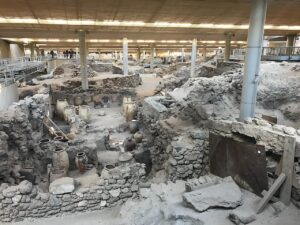High Art from the Time of Abraham, Christos G. Doumas, Biblical Archaeology Review (17:1), Jan/Feb 1991.

Ancient Akrotini. By Rt44 – Own work, CC BY-SA 4.0, https://commons.wikimedia.org/w/index.php?curid=75700197
Was this the lost continent of Atlantis? Did a volcano part the Red Sea?
BAR readers may well wonder what a small volcanic island—now a cluster of islands—in the Aegean Sea has to do with Biblical archaeology.
The answer is threefold. Most important, this article is about a high civilization that was destroyed about 1500 B.C. (or 1628 B.C., according to a recent dating—see the sidebar “Thera and the Exodus—When Was the Island Destroyed?” This dates it at least 300 years before Israel emerged as a people in the rustic highlands of Canaan, perhaps at a time when Israel’s patriarchal forebears were living as seminomads and certainly before the time of the Exodus and the Judges. To appreciate fully the ancient culture out of which Israel emerged, we must understand, even if by contrast, the contemporaneous world of the mid-second millennium. Thera, to use the Greek name of this Aegean island (today it is also called Santorini, a name given to it by the Venetians), was part of that world—reflecting a little-known but elevated culture that had maritime and trading contacts with much of the then-known world, especially to the east.
There are other reasons why students of the Bible will be interested in Thera.
Read the rest of High Art from the Time of Abraham in the online Biblical Archaeology Society Library.



